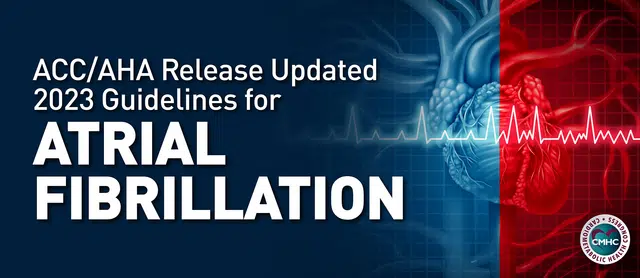The American College of Cardiology (ACC) and the American Heart Association (AHA) recently published new guidelines for the diagnosis and management of patients with atrial fibrillation (AF). These new guidelines provide necessary updates to both the 2014 AHA/ACC/HRS Guideline for the Management of Patients With Atrial Fibrillation and the 2019 AHA/ACC/HRS Focused Update of the 2014 AHA/ACC/HRS Guideline for the Management of Patients With Atrial Fibrillation. Furthermore, it includes the latest recommendations which specifically address AF and thromboembolic risk assessment, anticoagulation, left atrial appendage occlusion, AF catheter or surgical ablation, and risk factor modification and AF prevention.
Published on November 30, 2023, in the Journal of the American College of Cardiology, these new guidelines are based on a comprehensive literature review from May 2022 to November 2022, and provide important recommendations to clinicians caring for patients with or at risk of developing cardiovascular disease (CVD).
Background
Atrial fibrillation, the most sustained common arrhythmia, is increasing in incidence and prevalence in the United States and globally. This is due to several factors, including the aging of the population, a rise in obesity, increased detection, and increased survival with AF along with other forms of CVD. By 2030, it is estimated that AF prevalence in the United States will rise to 12.1 million.
AF is associated with an increased risk of death as well as multiple adverse outcomes, including stroke, cognitive impairment or dementia, myocardial infarction, sudden cardiac death, heart failure (HF), chronic kidney disease (CKD), and peripheral artery disease (PAD).
Given the staggering burdens of AF and its accompanying complications, updated protocols to refine risk stratification and standardize optimal management provide a reassuring roadmap for clinicians on the frontlines of this crisis.
Recognizing the breadth of this expansive 171-page report, the authors showcase 10 key takeaways upfront. These critical highlights offer a sneak peek into overarching issues and are outlined below.
1. Stages of AF
The previous classification of AF was based on arrhythmia duration which placed more emphasis on therapeutic interventions once AF was diagnosed. The new proposed classification instead uses stages, recognizing AF as a progressive disease requiring a variety of strategies at different stages, including prevention, lifestyle and risk factor modification, screening, and therapy.
The new AF stages are thus given as:
- At risk for AF (presence of modifiable and nonmodifiable risk factors associated with AF)
- Pre-AF (evidence of structural or electrical findings further predisposing a patient to AF)
- AF (different stages: paroxysmal AF (3A); persistent AF (3B); long-standing persistent AF (3C); successful AF ablation (3D))
- Permanent AF (no further attempts at rhythm control after discussion between patient and clinician)
By classifying AF in this way, it can be better seen as a more progressive disease with emphasis being placed on the importance of prevention, risk factor management, and timing for screening in those patients with the highest risk.
“The foundation of optimal AF management is the treatment of risk factors and implementing lifestyle changes to decrease the likelihood of developing AF.”
2. AF risk factor modification and prevention
These new guidelines recognize lifestyle and risk factor modification as a pillar of AF management, highlighting their importance in preventing the onset of AF, its progression, and adverse outcomes. For this reason, the guidelines place much emphasis on risk factor management throughout the disease continuum, offering recommendations such as obesity management, weight loss, physical activity, smoking cessation, alcohol moderation, hypertension, as well as other comorbidities.
The authors note that “AF should be thought of in a more holistic sense over an individual patient’s lifetime.” They add, “The foundation of care is treatment of comorbidities in all individuals to decrease the likelihood of developing AF and reducing its burden.”
3. Flexibility in using clinical risk scores and expanding beyond CHA2DS2-VASc for prediction of stroke and systemic embolism
Currently, recommendations for anticoagulation are made based on yearly thromboembolic event risk using a validated clinical risk score, such as CHA2DS2-VASc. It is noted however that patients who are at an intermediate annual risk score may benefit from the use of other risk variables to help inform the decision, or the use of other clinical risk scores to improve prediction, facilitate shared decision-making, and incorporate into the electronic medical record.
For stroke risk stratification and anticoagulation decisions, the update continues recommending CHA2DS2-VASc while now urging clinicians to also integrate additional validated risk scores like the ATRIA (Anticoagulation and Risk Factors in Atrial Fibrillation) and GARFIELD-AF (Global Anticoagulant Registry in the Field-Atrial Fibrillation) risk scores. This synergistic approach allows accounting for influential factors beyond the traditional thresholds, providing a more comprehensive risk profile to inform patient discussions.
4. Consideration of stroke risk modifiers
Patients with AF who are at intermediate to low (<2%) annual risk of ischemic stroke can benefit from consideration of factors that might modify their risk of stroke. This includes certain characteristics of their AF (eg, burden), nonmodifiable risk factors (sex), and other dynamic or modifiable factors (blood pressure control) that may inform shared decision-making discussions.
“AF is a lifelong condition and, thus, patient characteristics, risk factors, and net clinical benefit can and often will change over time. In long-term follow-up, stroke risk increases due to age and accumulation of other risk factors. Physiologic factors that impact stroke prevention therapy also change over time and can have important implications for proper medication dosing and patient safety. Typically, periodic assessments should be performed once a year but might need to be performed more frequently in the context of changes in clinical status, such as reduction in renal function or development of additional risk factors.”
5. Early rhythm control
With the emergence of new and consistent evidence, this guideline emphasizes the importance of early and continued management of patients with AF which should focus on maintaining sinus rhythm and minimizing AF burden.
“Antiarrhythmic drugs are reasonable for long-term maintenance of sinus rhythm for patients with AF who are not candidates for, or decline, catheter ablation or who prefer antiarrhythmic therapy.”
6. Catheter ablation of AF receives a Class 1 indication as first-line therapy in selected patients
Recent studies have demonstrated the superiority of catheter ablation over drug therapy for rhythm control in appropriately selected patients. As such, the Class of Recommendation for catheter ablation has been upgraded.
“More recent information has shown that ablation for AF is more effective than antiarrhythmic drugs for both persistent and paroxysmal AF and that earlier implementation of rhythm control strategies is an important factor for improving AF ablation success rates.”
7. Catheter ablation of AF in appropriate patients with heart failure with reduced ejection fraction receives a Class 1 indication
Recent randomized studies have demonstrated the superiority of catheter ablation over drug therapy for rhythm control in patients with heart failure and reduced ejection failure. Given the data, the Class of Recommendation for this population of patients has also been upgraded.
8. Recommendations have been updated for device-detected AF
Due to the findings of recent studies, more prescriptive recommendations are now provided for patients with device-detected AF that consider the interaction between episode duration and the patient’s underlying risk for thromboembolism. This includes considerations for patients with AF detected via implantable devices and wearables.
9. Left atrial appendage occlusion devices receive higher level Class of Recommendation
Data supports the upgrade of the Class of Recommendation on the safety and efficacy of left atrial appendage occlusion devices to 2a compared with the 2019 AF Focused Update for the use of these devices in patients with long-term contraindications to anticoagulation.
Reflecting a surge in supporting safety and efficacy evidence, left atrial appendage occlusion garnered an upgraded Class recommendation. Numerous studies substantiate these solutions to mitigate the risk of stroke and systemic embolism.
10. Recommendations are made for patients with AF identified during medical illness or surgery (precipitants)
Emphasis is made on the risk of recurrent AF after it is discovered during noncardiac illness or other precipitants, such as surgery.
“Patients with AF who are identified in the setting of acute medical illness or surgery should be counseled about the significant risk of recurrent AF after the acute illness is resolved.”
Looking Ahead
While these updated guidelines represent pivotal progress in preventative and management strategies, there remain important gaps in knowledge that need to be addressed. These include more long-term studies evaluating the consequences of AF, identifying better clinical markers for ablation candidates, the use of artificial intelligence for AF management, and standardizing ablation procedures.
Concluding Remarks
Jose Joglar, MD, professor of cardiac electrophysiology at UT Southwestern Medical Center in Dallas and chair of the writing committee states, “The new guideline reinforces the urgent need to approach AFib as a complex cardiovascular condition that requires disease prevention, risk factor modification, as well as optimizing therapies and patients’ access to care and ongoing, long-term management. [It] gives clinicians flexibility to use other predictive tools, and we hope this will also enhance communication and shared decision-making with patients.”
With AF prevalence continuing to rise, these updated guidelines couldn’t arrive at a more crucial turning point. Their extensive, evidence-based recommendations aim to advance identification, reduce disability, and alleviate psychological distress for millions through proactive triage and clarified treatment pathways integrating patient priorities.
Sources:
- Joglar, J, Chung, M. et al. 2023 ACC/AHA/ACCP/HRS Guideline for the Diagnosis and Management of Atrial Fibrillation: A Report of the American College of Cardiology/American Heart Association Joint Committee on Clinical Practice Guidelines. J Am Coll Cardiol. null2023, 0 (0). https://doi.org/10.1016/j.jacc.2023.08.017
- ACC/AHA Release Updated Atrial Fibrillation Guidelines for 2023. HCP Live.


















